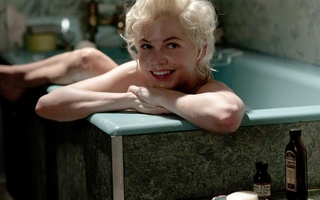
Marilyn Monroe (Michelle Williams) and Arthur Miller (Dougray Scott) walk the streets of Britain in Simon Curtis’s “My Week with Marilyn.”
The world knows Marilyn Monroe as an immortal sex symbol, but if one delves deeper into her life, one finds it rife with emotional struggles even more affecting than those in the dramas in which she acted. “My Week with Marilyn” investigates the more intimate moments of Monroe’s life, and goes behind the scenes to depict the true, unadulterated Monroe (Michelle Williams), sans makeup and bombshell demeanor. The film is based on the diaries of Colin Clark, a third assistant director on the 1957 movie “The Prince and the Showgirl,” who fell in love with the starlet and shared an emotional rollercoaster of a week with her during the filming.
For director Simon Curtis, Clark’s diaries provided a unique entry point into Monroe’s story. “Colin Clark’s point of view happened to [show] Marilyn in a different and unexpected light,” he says. Indeed, the movie depicts many facets of Monroe, some less familiar than others: the brilliant actor, confident sexy star, crazed pill-popper, and the sometimes arresting, articulate, self-assured woman. These various features of the renowned movie star combine to provide a fresh take on an actress typically portrayed as merely a bombshell blonde.
Curtis found the film’s particular period ideal for conveying a more complex perspective on Monroe. In 1956, Monroe had moved away from Hollywood and towards more challenging and substantive projects. “My Week With Marilyn” chronicles her experiences during the filming of “The Prince and the Showgirl,” a more highbrow film that starred and was directed by the distinguished actor Laurence Olivier. “She escaped Hollywood to find intellectual sustenance and credibility,” says Curtis.
To Curtis, Colin Clark’s material thus provided the opportunity to render a more complete vision of Monroe on screen. His Monroe repeatedly defies expectations in the movie and betrays far more complexity of character than traditionally associated with the actress. Initially portrayed as an incredibly self-conscious performer, she worries about her inability to connect to her character—fears that are quickly dismissed in the film by a glib “just try to be sexy, isn’t that what you do?” She bemoans this sort of typecasting and its effect on her life. “As soon as [people] realize I’m not Marilyn Monroe, they run,” she laments, in reference to her multiple failed marriages.
But although Curtis’s Monroe is first depicted as a “damsel in distress,” her self-awareness and personal acumen soon emerge. She has the sensibility to realize that her childhood, spent with a mentally ill mother and then in a series of foster homes, has shaped her into a dependent—both on people and mind-altering substances—and unstable person. “I just want to be loved like a regular girl,” she sighs during a difficult moment with her husband at the time, the playwright Arthur Miller (Dougray Scott). The film shows how this emotional instability, while personally destructive, was instrumental in crafting Monroe into an incredible actress—and the archetype of starlets of today.
Of course, depicting a character as iconic as Monroe is exceptionally difficult. There is a reason there haven’t been any other actresses who have left such a deep imprint upon society. For Curtis, casting a modern actress as such a legendary woman was especially tricky, given the complexity of Marilyn’s character in his movie. But Michelle Williams, who has proven her versatility and emotional scope in other acclaimed movies like “Blue Valentine” and “Brokeback Mountain,” seemed just the right choice. “Michelle is as good as doing the extrovert as she is doing the intimate, complicated screwed-up,” Curtis says.
“My Week with Marilyn” is essentially a snapshot of Marilyn Monroe’s life. Yet in that proverbial picture, she is striking multiple poses. The focus is not on her usual sexpot self, but a more real and relatable person. She is someone with emotional troubles, insecurities, and other human foibles. Later on, her more notorious drug-dependent characteristics emerge, briefly overcome in Monroe’s short-lived defiance of critics’ expectations and her own self-doubt. It is a multidimensional look at a figure often portrayed as one-dimensional. As Curtis puts it, the film is “a love letter to a lost time, and a love letter to a tremendous icon ... I hope we can sort of humanize her and bring her to people’s attention in an unexpected way.”
Read more in Arts
Herzog’s ‘Into the Abyss’ a Raw RevelationRecommended Articles
-
Trials for 1918 Debating TeamPreliminary trials for the Freshman debating team will be held in Harvard 6 next Thursday evening at 7 o'clock. Candidates
-
Western Immunologist Eaton Receives Medical School PostDr. Monroe D. Eaton, Director of the Research Laboratory of the State Department of Public Health in California, has been
-
Superficial ‘Opinions’ of Marilyn Monroe’s DogThe problem with “The Life and Opinions of Maf the Dog,” however, is not its aggressive self-presentation as such a comic novel; at times, O’Hagan’s narrative is indeed a clever outsider’s portrayal of the ultimate insider’s world. The problem, rather, is that O’Hagan’s obsession with his chosen genre seems to inhibit any substantive portrait of Marilyn Monroe whatsoever.
-
 ‘My Week with Marilyn’ Mesmerizes
‘My Week with Marilyn’ Mesmerizes -
 Monroe ’13 Remembered for Charisma On and Off the Field
Monroe ’13 Remembered for Charisma On and Off the Field













